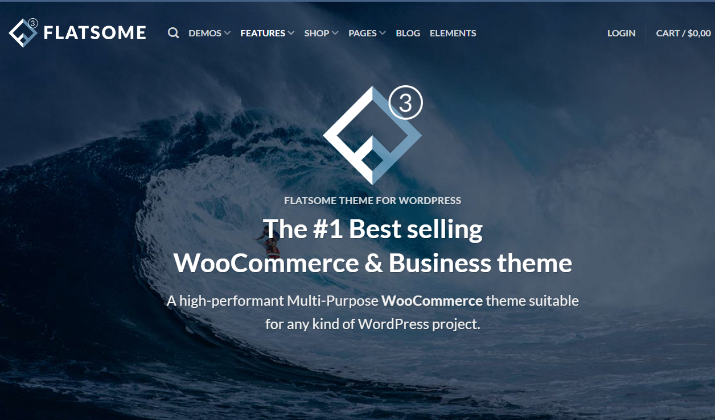In the world of WordPress themes, Divi and Flatsome stand out as two of the most popular choices among website builders and designers.
Both themes offer a unique blend of functionality, design flexibility, and user-friendly features, making them suitable for a wide range of projects, from personal blogs to ecommerce stores.
This article will delve into a detailed comparison of Divi and Flatsome, exploring their strengths and weaknesses across various aspects such as ease of use, customization options, performance, and more.
Whether you’re a seasoned developer or a beginner looking to create your first website, understanding the differences between these two themes will help you make an informed decision.
Let’s dive in.
Overview of Divi
Divi is a highly regarded WordPress theme developed by Elegant Themes, known for its versatility and powerful website-building capabilities.
It features a visual drag-and-drop builder that allows both beginners and experienced developers to create visually appealing websites without coding knowledge.
Key Features
- Visual Builder: Divi’s front-end visual builder enables users to design websites in real time, seeing changes as they make them. This intuitive interface supports drag-and-drop functionality, making it easy to manipulate elements on the page.
- Extensive Layout Options: With over 800 premade layouts and more than 100 full website packs, Divi provides a wealth of design options across various industries, allowing users to start with a template or build from scratch.
- Customization Tools: Divi offers a robust set of customization features, including hover effects, animations, and extensive control over every design aspect. Users can tailor their sites to be as unique as desired.
- Theme Builder: The Divi Theme Builder allows users to create custom templates for headers, footers, and other site elements, providing complete control over the website’s structure and design.
- Responsive Design: Divi is designed to be responsive by default, with additional tools that allow for precise adjustments on different devices, ensuring a seamless user experience across desktops, tablets, and smartphones.
Overall, Divi is a comprehensive solution for anyone looking to build a professional website efficiently, making it a popular choice among freelancers, agencies, and business owners.
Also read: Divi vs Framer
Trusted by over 970,000 web designers and businesses worldwide. Design beautiful websites. Quick & Easy!
Introduction to Flatsome
Flatsome is a versatile WordPress theme developed by UX-themes, primarily designed for creating ecommerce websites using WooCommerce.
Since its launch in 2013, it has gained immense popularity and is recognized as one of the best-selling themes on platforms like ThemeForest.
Flatsome combines aesthetic appeal with robust functionality, making it suitable for a wide range of website types, from online stores to corporate sites.
Key Features
- UX Builder: Flatsome includes a powerful drag-and-drop page builder known as the UX Builder, which allows users to create custom layouts and designs effortlessly. This feature is beneficial for those who want to build interactive and visually appealing pages without coding.
- Responsive Design: The theme is built with a mobile-first approach, ensuring that websites look great on all devices. Its responsive design automatically adjusts to different screen sizes, providing a seamless user experience.
- Pre-Built Demos: Flatsome offers a library of pre-built demo sites and templates that users can import and customize. This feature significantly reduces the time needed to set up a new website, catering to various niches and styles.
- Performance Optimization: Flatsome is designed for speed, utilizing a lightweight framework that ensures fast loading times. The theme supports lazy loading for images and has been optimized for SEO, making it a strong contender for search engine rankings.
- WooCommerce Integration: As a WooCommerce-focused theme, Flatsome provides extensive eCommerce features, including product quick views, catalog modes, and customizable checkout pages. This makes it an ideal choice for users looking to establish or enhance their online stores.
Flatsome stands out as a comprehensive solution for anyone looking to create a professional and engaging online presence, particularly in the ecommerce sector.
Its combination of aesthetic design, functionality, and performance makes it a popular choice among website builders.
Check out: Figma vs Divi
Ease of Use
Divi
Divi is widely recognized for its user-friendly interface, primarily due to its powerful visual builder. The drag-and-drop feature allows users to create and edit pages in real time, making it accessible even for those without coding experience.
It offers a vast array of design options, including over 800 pre-made templates and advanced customization tools, which can be easily navigated through its intuitive dashboard.
Users can implement features like undo/redo functionality and bulk editing, enhancing the overall editing experience.
Flatsome
Flatsome also provides a user-friendly experience, particularly for eCommerce sites, leveraging its UX Builder to facilitate real-time page building.
While it offers a solid selection of pre-built demos and customization options, it is generally considered less extensive than Divi’s offerings.
Flatsome’s focus on WooCommerce integration makes it particularly effective for online stores, but some users may find its customization options to be more limited compared to Divi’s extensive capabilities.
Explore: Divi vs Elementor vs Visual Composer
Design Options & Customization
Divi
Divi is renowned for its extensive design options and advanced customization capabilities. It features a powerful visual builder that allows users to create layouts in real time using a drag-and-drop interface.
Here are some of its key aspects:
- Vast Template Library: Divi provides over 800 pre-made website templates and 2,000+ design elements, catering to various niches and styles. This extensive library allows users to quickly start their projects and customize them as needed.
- Advanced Design Controls: Users have access to a wide range of design settings, including custom CSS, hover effects, animations, and more. The ability to save designs for later use and implement bulk editing enhances the customization process.
- Flexible Layout Options: Divi supports various layout configurations, enabling users to create complex designs without coding knowledge. The theme’s settings allow for detailed adjustments, such as shape dividers and countdown timers, further enhancing design flexibility.
Flatsome
Flatsome, while primarily focused on ecommerce, also offers solid design options but with a more streamlined approach. Its strengths include:
- WooCommerce Integration: Flatsome is specifically designed for online stores, providing tailored design elements and templates that enhance the shopping experience. This includes product quick views, wishlists, and customizable product pages.
- Pre-Built Demos: The theme includes a variety of pre-built demos optimized for eCommerce, allowing users to set up their online shops quickly. However, the selection is more limited compared to Divi’s extensive offerings.
- User-Friendly Customization: Flatsome’s UX Builder is intuitive and allows for real-time customization, but it may not offer the same depth of design options as Divi. Users can adjust image sizes, block placements, and theme colors, but the overall flexibility is somewhat less than that of Divi.
For users prioritizing a broad range of design choices, Divi is the clear winner, while Flatsome is optimal for those specifically building online stores with a focus on user experience.
Read this too: Kadence vs Divi
Trusted by over 970,000 web designers and businesses worldwide. Design beautiful websites. Quick & Easy!
Performance & Speed
Divi
Divi has made significant strides in performance, particularly with the introduction of Divi 5. Take a look at the vital parameters:
- Page Load Speed: Divi averages a Google PageSpeed Insights score of 90%, with a first contentful paint (FCP) time of approximately 0.7 seconds. However, its extensive features and heavy interface can lead to slower loading times compared to lighter themes.
- Resource Usage: While Divi offers a wealth of design options and functionalities, this can result in a bulkier setup, which may impact speed, especially in resource-constrained hosting environments.
- Optimizations: Recent updates have focused on improving load times and reducing memory usage, making Divi more competitive in terms of performance.
Flatsome
Flatsome is recognized for its speed and efficiency, particularly for ecommerce sites:
- Page Load Speed: Flatsome scores higher on speed tests, averaging a Google PageSpeed Insights score of 96%, with an FCP of around 0.6 seconds. This indicates a faster loading experience for users.
- Lightweight Design: The theme’s simpler interface and fewer features contribute to its speed, making it a more efficient option for users prioritizing quick load times.
- WooCommerce Optimization: Flatsome is specifically designed for WooCommerce, which allows it to maintain high performance while delivering essential eCommerce functionalities.
Users looking for a balance between design flexibility and speed might find Divi appealing, but those focused primarily on performance should consider Flatsome as the superior option.
Also read: Divi vs Elementor vs Gutenberg
Customer Support & Documentation
Divi
- Support Center: Divi provides a comprehensive Support Center that includes system status reports, remote access for support agents, and extensive documentation. This allows users to troubleshoot issues efficiently and access help directly from within their Divi installation.
- Documentation: Divi’s documentation is extensive and beginner-friendly, featuring step-by-step guides, video tutorials, and detailed explanations of features. This makes it easier for users to learn how to use the theme effectively.
- Customer Support: Divi offers dedicated customer support through various channels, including live chat and email. Users rate Divi’s support highly, appreciating the responsiveness and expertise of the support team.
Flatsome
- Support and Documentation: Flatsome also provides solid documentation, but it is generally considered less extensive than Divi’s. While it includes guides and FAQs, some users may find that it lacks the depth and breadth found in Divi’s resources.
- Customer Support: Flatsome offers six months of support with the purchase of the theme, with options to extend this period for an additional cost. While the support is generally helpful, users have rated it slightly lower than Divi’s, indicating that response times and issue resolution may not be as robust.
Flatsome, while still providing valuable support and documentation, may not match the level of service and resources available with Divi.
For users who prioritize ongoing support and detailed guidance, Divi is the preferable option.
Check out: Divi vs Avada
Drag-drop Builder
Both Divi and Flatsome come equipped with powerful drag-and-drop builders, making website customization a breeze even for those without coding experience.
This intuitive feature eliminates the need for complex coding and allows you to visually design your website in real-time.
Divi
Divi’s drag-and-drop builder is known for its extensive range of backend development options. It offers advanced features that give you more control over the design and functionality of your website.
The builder’s flexibility and vast library of elements enable you to create unique and dynamic designs with just a few clicks.
With Divi’s drag-and-drop builder, you can customize your website to reflect your brand and style effortlessly. Its advanced features and versatile design options allow you to create a unique online presence that stands out from the competition.
Flatsome
Flatsome’s drag-and-drop builder provides a user-friendly interface but is more limited in terms of available elements compared to Divi.
While it offers essential customization features, Divi’s builder has an edge when it comes to the level of customization and variety of options.
Flatsome’s builder, while simpler than Divi’s, still provides enough tools to help you create a visually appealing website.
SEO Friendliness
Divi
Divi is designed with SEO optimization in mind. Its clean code structure ensures that search engines can easily crawl and index your website, improving its chances of ranking higher.
It also offers lifetime access to updates and support, providing you with peace of mind knowing that your website will always be up-to-date with the latest SEO practices.
Additionally, Divi supports clean URLs, allowing search engines to understand your website’s structure more effectively.
Flatsome
Flatsome supports SEO optimization, ensuring that your eCommerce website has better visibility in search engine results. Its clean coding structure and optimized codebase contribute to improved loading times, which is a crucial factor for SEO.
Trusted by over 970,000 web designers and businesses worldwide. Design beautiful websites. Quick & Easy!
Page Builder Integration
Divi
Divi’s page builder, known as the Divi Builder, is one of the most popular options on the market. It provides a seamless and intuitive drag-and-drop interface that allows you to build your pages visually.
With over 40 design elements and unlimited customization options, you have complete control over the look and feel of your website.
Whether you want to create a simple blog page or a complex ecommerce site, Divi’s page builder has you covered.
Flatsome
Flatsome also has its page builder, which is specifically designed for users of the Flatsome theme.
With Flatsome’s page builder, you can easily create custom layouts using its extensive library of over 40 elements for general content and WooCommerce elements.
The drag-and-drop functionality makes it simple to arrange and customize your website’s elements in real time.
Both Divi and Flatsome’s page builders offer real-time editing, allowing you to see your changes instantly. This makes it convenient for users to experiment and fine-tune their designs until they achieve the desired look.
Read this too: Divi vs Astra
WooCommerce Integration
Divi
Divi offers extensive WooCommerce features that make it easy to set up and manage your online store. With Divi, you get access to pre-designed templates specifically designed for e-commerce websites.
This means you can quickly create product pages, shopping carts, and checkout processes that are optimized for conversions.
In addition, Divi provides advanced product customization options, giving you the flexibility to showcase your products exactly how you want.
Flatsome
While Divi is WooCommerce compatible, Flatsome takes it a step further by being specifically designed for WooCommerce websites.
With Flatsome, you have access to a wide range of customization options for your checkout process, shopping cart design, product catalog, and payment icons.
The level of customization ensures that your online store not only looks great but also provides a seamless shopping experience for your customers.
Flatsome has gained a reputation for its excellent WooCommerce integration. It provides all the necessary tools and features to create a successful online store that drives conversions.
Whether you’re a small business owner or a seasoned ecommerce entrepreneur, Flatsome’s focus on ecommerce functionality makes it a top choice for building a WooCommerce store.
Pricing & Value for Money
Divi
Divi offers four pricing plans – two are yearly plans and the other two are lifetime access plans. Here is a quick look at these four plans:
- Divi: This plan intended for WordPress Professionals and website owners is priced at $80 per year. It enables access to Divi’s no-code builder to quickly create professional-looking websites.
- Divi Pro: Priced at $250 per year, this plan is suitable for web professionals looking for AI tools for faster website building.
- Divi Lifetime: If you are looking for ways to utilise Divi’s user-friendly builder to create websites, try this lifetime plan that comes with a one-time payment of $224.
- Divi Lifetime+ Pro Services: In case, you require advanced features and premium support, this plan is a great option. Priced at $265 per year, this plan offers powerful AI tools, cloud storage and VIP support. There is an additional payment of $191 each following year for access to Pro services.
Divi is often considered to provide superior value due to its extensive features and flexibility.
With access to over 800 pre-made templates, a powerful visual builder, and a large community, users can create a wide range of websites, from business to personal projects.
The lifetime plan, in particular, is appealing to long-term users who want to avoid recurring fees. Divi also provides a 30-day money-back guarantee, so that users can try its features risk-free.
You might like this: Divi Free Trial
Trusted by over 970,000 web designers and businesses worldwide. Design beautiful websites. Quick & Easy!
Flatsome
Flatsome is priced at $59 for a standard license, with an optional extended support plan available for an additional $17.63, bringing the total to approximately $76.63 for the first year.
This pricing is significantly lower than Divi’s, making Flatsome an attractive option for budget-conscious users.
While Flatsome is cheaper, it is primarily focused on ecommerce, offering features tailored for online stores, such as product quick views and customizable product pages. It lacks the extensive range of templates and features available with Divi.
Users looking specifically for an ecommerce solution may find Flatsome’s features sufficient, but those needing broader capabilities might see Divi as a better investment.
Conclusion
Both the themes present compelling options for different user needs.
Divi shines with its extensive design flexibility, powerful visual builder, and comprehensive customer support, making it ideal for those seeking a versatile solution for various websites.
On the other hand, Flatsome delivers a streamlined, performance-oriented experience specifically tailored for eCommerce, offering excellent value at a lower price point.
Ultimately, the choice between Divi and Flatsome will depend on your specific requirements—whether you prioritize broad design capabilities or a focused ecommerce solution.

















